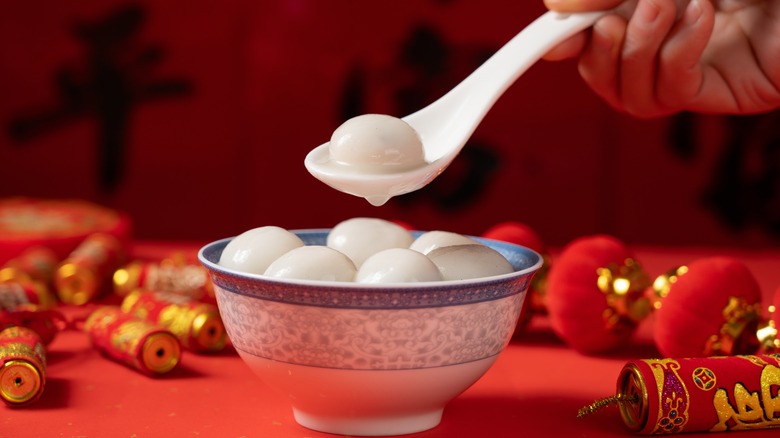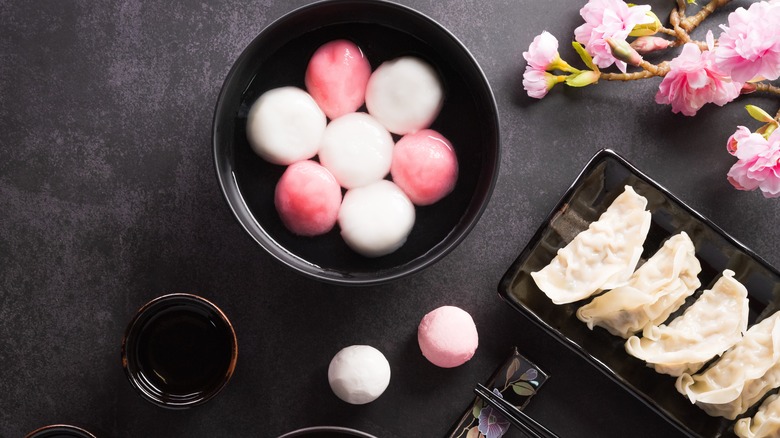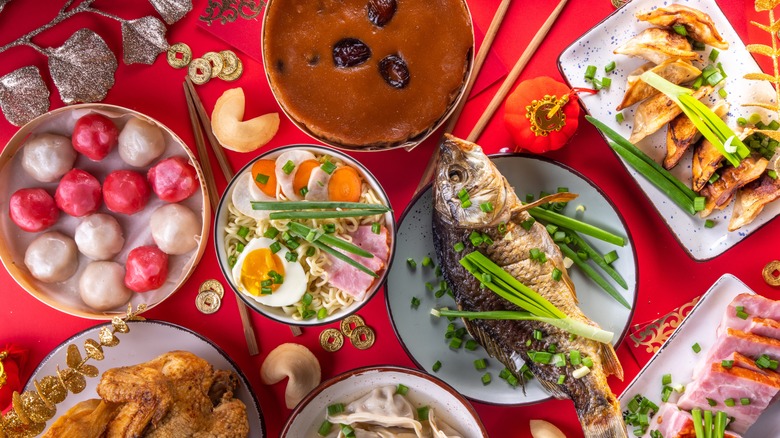Understanding The Importance Of Dumplings During Lunar New Year
Based on moon cycles, the Chinese lunar calendar was the astral benchmark used to time sowing and harvest seasons and (for the last 3,000 years or so) mark when it was time to celebrate the new year. The Chinese New Year — also the Lunar New Year — is celebrated on the new moon between late January and early February. The festivities last about two weeks, culminating in the Lantern Festival on the new year's first full moon.
So, where do dumplings — tang yuan in Chinese — come into the picture? For many families, making and consuming the plush stuffed white rice balls together remains a quintessential part of the Lunar New Year celebrations. Dumplings, both crescent or round, resemble phases of the moon. They also look similar to the Chinese Tael (an East Asian currency measure of yore) and symbolize wealth and prosperity. The stuffing, too, is considered auspicious, and a clean coin is sometimes hidden in a dumpling to boost the good fortunes of whoever finds it.
Food and New Year celebrations go back a long way, entangled in a delicious blend of astronomy and lore with traditions steeped in mythological stories and socioeconomic realities. Dishes like noodles and rice cakes also hold significance, but the dumpling occupies an especially soft and squishy corner of the heart when celebrating the Lunar New Year.
Dumplings look like the moon and signify good fortune
Since Chinese New Year centers around the moon, the visual similarities of dumplings are often cited as why they are relevant to the celebration. Apart from the crescent and round shape, round dumplings floating in boiling water as they cook are also reminiscent of a full moon suspended in the sky under which people gather and rejoice. The Chinese phrase tuan yuan, which means reunion, sounds a lot like the word for dumplings, tang yuan, and the connection between the two is underscored by the fact that Chinese New Year is a time for families to reunite and share time during the event.
So, making dumplings is typically a family affair, and the eve of Lunar New Year is spent shaping, cooking, and consuming the delicious glutinous rice flour balls with a variety of stuffings. Tang yuan can be sweet or savory — sesame sugar, bean paste, and jujube fillings for the former, and peanuts, minced meat, and mushroom stuffings for the latter.
As E.N. Anderson, Anthropology Professor Emeritus at the University of California, told NPR, making dumplings during New Year celebrations grew out of the need to stretch meat and flour rations, as food stores were often low this late in the winter. Historically, starvation was a common cause of death, which is why wealth, longevity, and fertility were wished upon all those who ate dumplings; the delicious stuffed rice balls still carry this significance.
Symbolic foods of the Chinese New Year and the Lantern Festival
Though the tang yuan dumpling is one of the most well-known, the Chinese New Year and subsequent Lantern Festival are brimming with symbolic foods and traditions. Another dumpling is the yuan xiao, which is almost always sweet and filled with crushed black sesame seeds, bean paste, and sometimes fruit. While tang yuan is more prevalent in South China, yuan xiao is favored in the North. Also popular are glutinous rice cakes called nian gao, which sounds almost identical to the Mandarin phrase for a prosperous year.
Traditional foods like long noodles and whole fish signify long life, while peaches and peach blossoms are seen as fertility blessings. As the Lantern Festival comes around, marking the end of the New Year celebrations, red, the color of blood, becomes key as it represents life and good health. Tangerines, with their deep red flesh, are therefore favored. The color is also splashed across festivities — red paper lanterns are iconic, and children are also given money in red packets, keeping with the theme of Lunar New Year celebrations —enduring hope of prosperity and good health.
For those unable to be home during Chinese New Year for a meal shared with loved ones, dinner parties featuring hot pot have become increasingly popular. More practical for young people with limited time, resources, and kitchen experience, this fun communal dish that's a staple of Chinese households is a gateway to nostalgia and feelings of togetherness.


